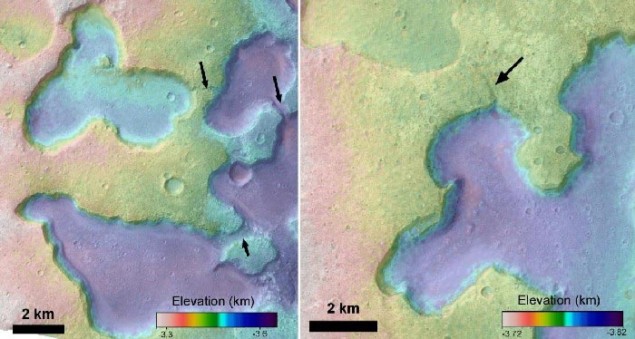
Early Martian history may have involved more water on the planet’s surface than was previously thought. That is according to researchers in the UK who have identified a series of geological features on the planet’s surface, which they claim could only have been formed by running liquid. One tantalizing consequence is that primitive life could have had greater opportunity to evolve before the planet became a frozen wasteland.
Since the 1970s when NASA’s Viking mission returned detailed images from the Martian surface, scientists have been in broad agreement that water was present on Mars at the very beginning of its history. Most believe, however, that once the planet entered its “Hesparian Epoch” approximately 3.5 billion years ago, the temperatures at the Martian surface plummeted and any remaining water turned to ice. If life had begun to emerge on the early Mars then it would have become very difficult to sustain in these cold conditions.
In this latest research, a team led by Nicholas Warner of Imperial College London suggests that this is not necessarily the case. By studying images captured by a camera on NASA’s Mars Reconnaissance mission, the researchers focused on a series of depressions around parts of the planet’s equator. The formation of these features was dated at no more than 3 billion years ago by counting the number of crater impacts – a method originally developed by NASA scientists to determine the age of geological features on the Moon.
Previously, it had been assumed that these features were formed by ice converting directly to water vapour in the process of sublimation. However, the high resolution of the new images enabled Warner and his colleagues to spot a number of narrow channels connecting individual depressions, and this has led them to a different conclusion about the formation. They attribute these landscapes to the same processes responsible for the “thermokarst” landscapes common in Siberia and Alaska, in which areas of melting permafrost cause water to trickle to lower elevations under gravity.
“Scientists had largely overlooked the Hesperian epoch because it was thought that Mars was then a frozen wasteland,” says Warner. “Excitingly, our study now shows that this middle period in Mars’ history was much more dynamic than we previously thought.”
Richard Soare, a physical geographer at Dawson College in Canada agrees that the images do bear a strong resemblance to terrestrial thermokarst regions. He told physicsworld.com that very little has been written about permafrost degradation on Mars during this early period of Mars history. “This work provides a substantial first step in this direction,” he says.
Determining the extent and distribution of liquid water is an important aspect in probing the question of whether life could have emerged on the planet. Warner and his team intend to develop their research by analysing spectrographic data from the depressions and their surrounding regions in search of hydrated minerals. “Very little is known about these crater regions and it is still not clear whether they will be too dusty to probe the underlying chemistry,” Warner told physicsworld.com.
This research is published in the journal Geology.



